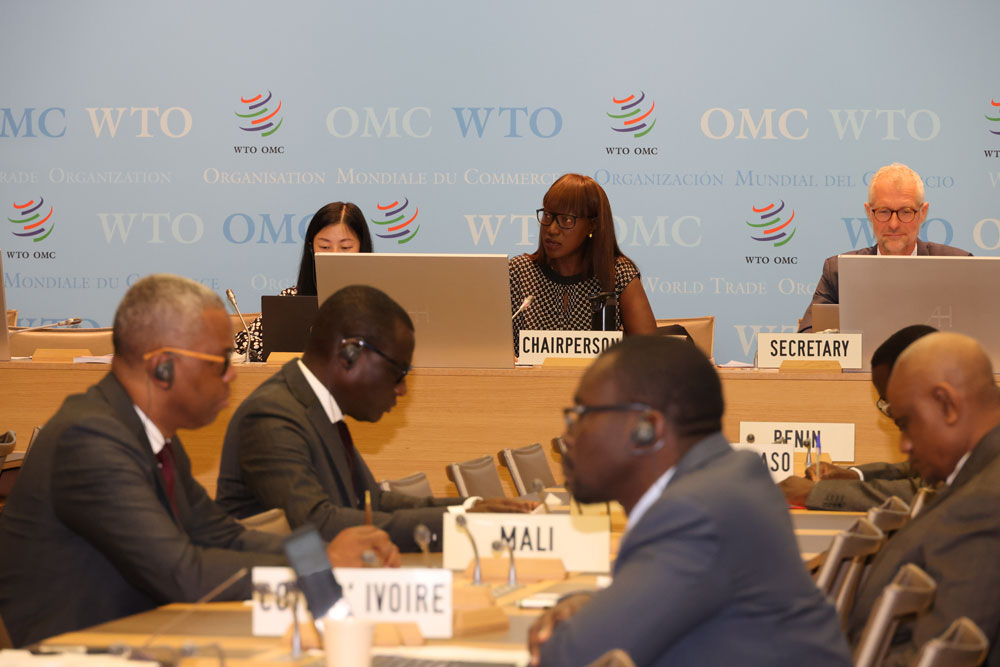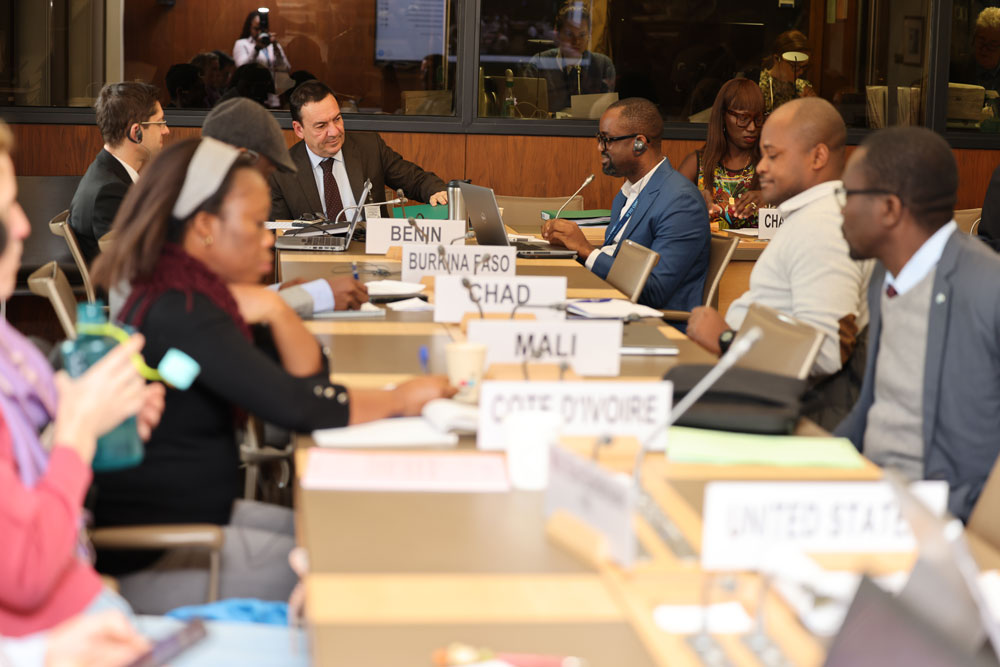COTTON SUB-COMMITTEE
More
Deputy Director-General Xiangchen Zhang, acting on behalf of Director-General Ngozi Okonjo- Iweala, chaired the meeting on the development dimension of cotton on 10 November while Marieme Fall, Officer in charge of the Agriculture and Commodities Division of the WTO, facilitated the discussion on cotton trade on 9 November in the absence of an agriculture negotiations chair.
A roundtable discussion, opened by Deputy Director-General Jean-Marie Paugam, looked into the availability and affordability of fertilizers for cotton farmers and ways to mitigate negative market conditions.
Members seek a fresh start for negotiations
At the dedicated discussion on cotton trade on 9 November, Ms Fall, noted that members were unable to agree on a work plan for agriculture negotiations, including cotton, at the 12th Ministerial Conference (MC12) in June, and drew attention to the last report by the previous chair, Ambassador Gloria Abraham Peralta. In this report, the chair regretted the low level of engagement on cotton-specific trade-distorting domestic support despite all the efforts by her predecessors and invited members to adopt a fresh approach. This “might require a candid exchange between the proponents and other key players” and “a better understanding of the existing state of play regarding cotton support”, Ms Peralta had added.
The need to approach the agriculture negotiations with fresh thinking, building on post-MC12 momentum, was also stressed at the agricultural retreat held on 24 October, Ms Fall added, highlighting the useful discussions at the retreat on how to remove obstacles that have stymied progress in negotiations to date.
The Cotton-4 reiterated the importance of cotton in their countries' economic and social development, flagging its contribution to food security, job creation, income generation and social inclusion. Regretting the impasse in the agriculture negotiations, the C-4 urged members to increase their engagement. They also called for an open, transparent, inclusive and balanced outcome at MC13, including on cotton, in line with the commitment made in 2005 to address cotton ambitiously, expeditiously and specifically.
Several members underscored the critical role of cotton in the livelihood of farmers in cotton-producing countries. They also shared their sense of urgency in making progress on cotton negotiations. In addition to trade-distorting domestic support, some members also referred to issues such as improving market access and enhancing transparency. Several members also underscored the need to have evidence-based negotiations.
Trade trends in cotton: positive signs and challenges
Members discussed the latest analysis of cotton production and trade trends undertaken by the International Cotton Advisory Committee (ICAC). They also reviewed the short- and medium-term outlook for the C-4's cotton markets, as presented by the UN Food and Agriculture Organization (FAO).
Both studies underlined the unfavourable market climate resulting from the COVID-19 pandemic, geopolitical tensions and a potential economic recession.
Cotton prices fell considerably towards the end of the 2021-22 season and at the beginning of the 2022-23 season due to concerns about inflation and potential recession, the ICAC said. In addition, global production in the 2022-23 season is outpacing or on a par with consumption as global demand is decreasing.
Cotton exports in 2021-22 declined by 9%, reaching 9.7 million tonnes, while west African cotton exports remained stable, following the 1.19 million tonnes of exports recorded in 2020-21, the ICAC stated. The downward trend in exports is expected to continue into 2023, with a further drop of 3.2% predicted. The ICAC also estimated government subsidies in 2021-22 at USD 3.5 billion, 57% lower than the previous season and the lowest level since 2010-11.
The FAO said cotton production in the Cotton-4 is projected to increase in the coming years, provided appropriate action is undertaken, including promoting sustainable standards, empowering women and youth, supporting textile manufacturers, reducing trade-distorting subsidies and broadening market access to least developed countries (LDCs).
The Cotton-4 aired their concerns regarding the drop in demand. Noting the Cotton-4's interest in mitigating climate change and pest risks, the FAO said risk management mechanisms in relation to cotton are important tools for climate adaptation and pest control.
The WTO Secretariat introduced its updated “background paper” (TN/AG/GEN/34/Rev.17 and two addenda) compiling the latest information on cotton policies in domestic support, market access and export competition.
Roundtable on fertilizers and cotton
In his opening remarks at a side event on fertilizers, DDG Paugam stressed the strategic importance of boosting cotton production and ensuring food security for cotton-producing countries. Due to export restrictions and higher input costs for fertilizer, global prices have reached record highs, exacerbating the pressure on all agriculture output, including cotton, he said. Therefore, keeping trade open for fertilizers and other agriculture inputs is key to tackling food insecurity. The WTO has been monitoring the situation closely, calling for trade policy transparency, he added.
The event looked into the current market situation for fertilizers and viable alternatives for cotton producers. It also shed light on how to strike a balance between improving cotton yields, meeting market needs and achieving sustainable development objectives, such as organic fertilization.
Development assistance and South-South cooperation
The latest “Evolving Table on Cotton Development Assistance” prepared by the WTO Secretariat provides updates on the implementation and disbursement of development assistance for cotton, with four new projects reported by the European Union and disbursements and project completions by Brazil, Canada Japan, and the United Nations Conference on Trade and Development (UNCTAD).
The table shows an increase in active projects both in cotton-specific development assistance (29 projects totalling USD 225 million) and in agriculture and infrastructure-related development assistance (41 projects totalling USD 2.073 billion).
Several members reported on their latest activities, with some developing members providing updates on their efforts to strengthen South-South cooperation in the cotton sector.
The Brazilian Cooperation Agency and the FAO introduced their joint Cotton+ project in Latin America, which aims to leverage new technologies to improve soil fertility and enhance cotton yields for family farmers. The ICAC also shared results regarding soil management, detailing the use of charcoal made from biological material (biochar) to improve soil health, reduce acidity and boost cotton production.
The Cotton-4 welcomed the work done at the WTO to increase the visibility of cotton and to channel resources to support the cotton value chain, ranging from World Cotton Day 2022 and the signing of a “call for action” on cotton to the African Export and Import Bank (Afreximbank)'s pledge of USD 300,000 for supporting African cotton and the Memorandum of Understanding signed by the WTO and FIFA.
However, more needs to be done, the Cotton-4 said. It renewed its call for development partners' support for its “Route du Coton” (WT/CFMC/W/72 and WT/CFMC/W/73) and highlighted the importance of technology transfer and scaling up good practices from other agricultural products.
Other matters
The meeting heard a briefing from the FAO about its activities regarding World Cotton Day 2022. The WTO and other stakeholders highlighted their participation in the event and discussed possible future initiatives.
The Cotton-4 welcomed the new WTO e-learning course on cotton launched by the WTO Secretariat with the aim of increasing cotton-related knowledge through online training.
More
Presentations and statements are available on the following web pages:
- WTO | Special Meeting of the Committee on Agriculture in Special Session
- WTO | Director-General's Consultative framework mechanism on Cotton 38th Round of consultations on cotton development assistance
- WTO | ROUND TABLE - THE CURRENT MARKET SITUATION FOR FERTILIZERS AND VIABLE ALTERNATIVES FOR COTTON PRODUCTION
Share


Share
Problems viewing this page? If so, please contact [email protected] giving details of the operating system and web browser you are using.